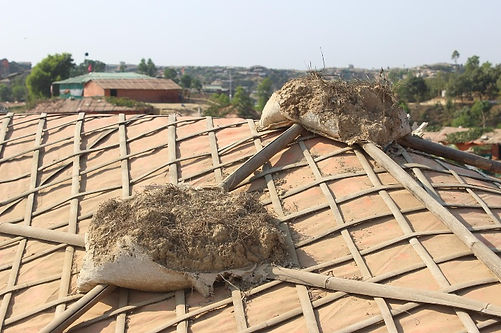
Extensive community consultations were conducted at the Rohingya Refugee Camp to ensure that solutions were contextually appropriate. Innovations to improve food security and thermal comfort were identified all across the settlement. Pictured below are rooftop planters used for growing spinach.

Safer Communities Innovation Lab
Project Coordinator, Architect
client: Disasters & Emergencies Preparedness Programme Lab
location: India, Bangladesh
year: 2018-19
"The DEPP Innovation Labs supported local-level innovation to strengthen disaster preparedness. The programme aimed to build solutions with communities at risk of crises to reduce the risk they face and to protect lives."
-START Network
The Safer Communities Innovation Lab, funded by the START Network, aimed to improve the overall climate and disaster resilience of slums in Bangladesh and India through technical and entrepreneurial support. A humanitarian innovation approach modeled around Asset Based Community Development was adopted to identify innovative solutions that residents had come up with to improve their living conditions.
I led a team of architects to work closely with these innovators and their communities to develop design solutions that address the chief concerns identified by community members: chronic heatwave-related health issues, massive fires, flooding, water shortage, food insecurity, and crime. These design solutions were prototyped and tested at local sites and, eventually, scaled by setting up businesses that slum residents could run and profit from.
Design solutions pertained to retrofits that improved the thermal comfort and fire resilience of individual dwelling units and neighborhood blocks, space-efficient urban farming bolstering food security, and several improvements around water access and sanitation.
Businesses offering these design solutions were set up in Karail Slum, Bangladesh. Local relationships were created to bring these improvements to the Rohingya Refugee Camp--home to over a million refugees, where the design solutions were refined and contextualized.
Traditional community engagement methods were modified, and innovative arts-based programming was used to navigate these informal settlements' complex political and socio-economic landscape. Due to low literacy levels, jargon such as "innovation" and "resilience" had to be re-articulated to be understood by communities already apprehensive of non-profit support. For example, a cartoon character called "Inno"- a creative kid with a penchant for solving problems- was created to explain the concept of innovation.
The overall humanitarian innovation process developed for this project was widely praised. It led to the creation of an online course that low-income communities all over the world could access and benefit from. I had the honor of delivering talks and teaching several course modules.


